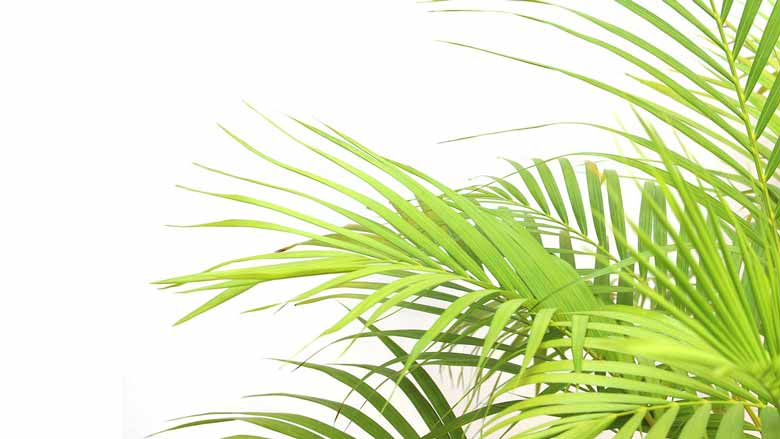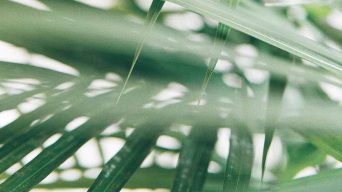Yellow palm leaves can result from overwatering, underwatering, excessive or insufficient sunlight, nutrient deficiencies, pests, diseases, temperature stress, transplant shock, or natural aging. To address, adjust watering, sunlight, soil nutrients, and protect from pests or diseases. Trim yellow fronds moderately and embrace the natural cycle. Prevention and proper care promote vibrant, green palm foliage.
Yellowing leaves in Palms is a common issue that many people face.
Nothing is more beautiful than palm trees in a landscape, but it can be alarming when their fronds begin to turn yellow.
Palm yellow leaf problems can range from too much sun or not enough sun to nutrient deficiency, pest infestation, and natural plant leaf aging.
Here, we will explore the ten most common causes of yellow palm leaves and provide solutions.
What Causes Palm Leaves To Turn Yellow and How To Solve It
Palm trees are an ever-popular landscaping choice for many reasons.
Their tropical feel can make any home feel like a vacation getaway, and are relatively easy to maintain.
However, even the most low-maintenance plants can have problems from time to time.
One such problem is when palm leaves turn yellow.
Yellow fronds on palms can be caused by several things, some of which are easy to solve, while others may require the help of a professional.
Here are the ten most common causes of yellow leaves on palms and what you can do to fix the problem.
1. Overwatering
One of the most common reasons for yellow palm leaves is overwatering.
Palm trees need a lot of water, but they also need well-draining soil.
If the soil is constantly wet, it will suffocate the roots and cause the leaves to start turning yellow.
Overwatering palm trees can also lead to fungal growth, further damaging the roots and leaves.
Other common signs of overwatering include:
- Soggy or wet soil
- Soil that smells bad
- Leaves that are wilting or drooping
- Yellow or brown spots on the leaves
- Fungal growth on the leaves or trunk
- Root rot
Rectifying Excessive Watering
The best way to fix overwatering is to let the soil dry completely between waterings.
You can also amend the soil with sand or gravel to improve drainage.
You may need to repot the tree in fresh, well-draining soil if the roots are damaged.
2. Underwatering
Underwatering is another common reason for yellow palm leaves.
Palm trees need much water to stay healthy; their fronds will turn yellow if they don’t get enough.
When a palm tree is drought-stressed, it cannot absorb essential nutrients from the soil and start to shed leaves.
Other common signs of underwatering include:
- Dry, dusty, or cracked soil
- Drooping palm leaves
- Brown tips on the leaves
- Soil that pulls away from the sides of the pot
Correcting Insufficient Watering
If your houseplant is not getting enough water, you must water it more frequently.
Ensure to water the soil, not the leaves, and allow the soil to dry out between waterings.
Water deeply so that the water reaches the roots. You may also need to amend the soil with organic matter to help retain moisture.
3. Too Much Sunlight
Palms need a lot of sunlight to stay healthy, but too much sun can damage the leaves and cause them to start turning yellow.
When the fronds are exposed to direct sunlight for too long, they scorch.
This usually happens in the summer when the sun is at its strongest.
Other common signs of too much sunlight include:
- Plant leaves that are yellow or brown
- Leaves that are wilting or drooping
- Scorched or dried out leaves
Adjusting Sun Exposure
If your palms are getting too much sunlight, you will need to move them to a shadier spot.
Palms need bright indirect light, so a spot that gets some sun in the morning and afternoon but is shaded during the midday hours is ideal for maintaining an optimal environmental conditions.
You can also try draping a light cloth over the Palm to filter out some sunlight.
4. Too Little Sunlight
While too much sunlight can damage plant leaves, too little sunlight can cause problems.
Palms need a lot of light to stay healthy; if they don’t get enough, their fronds will turn yellow.
When a palm tree grows in low-light conditions, it cannot produce the chlorophyll it needs to stay green.
Other common signs of too little sunlight include:
- Leaves that are yellow or pale green
- Slow growth
- Small leaves
Enhancing Sunlight for Healthy Palms
The health of your palm tree is directly linked to its sunlight exposure. If it’s not getting enough sunlight, relocate it to a brighter area.
Palms flourish in bright indirect light, so choose a spot that receives morning and afternoon sun while offering shade during midday for optimal health.
Beyond strategic placement, bolster your palms’ well-being by adding grow lights.
These artificial lights are particularly beneficial in indoor settings or places with restricted direct sunlight, effectively supplementing natural sunlight.
5. Nutrient Deficiencies
Nutrient deficiencies are another common reason for yellow leaves.
Palms need several different nutrients to stay healthy; if they don’t get enough of one or more of them, their leaves will start turning yellow.
Nutritional deficiencies in Palms can be caused by poor soil quality, improper fertilization, or a lack of nutrients in the water.
Common nutrient deficiencies include:
- Nitrogen deficiency: leaves are yellow with green veins
- Magnesium deficiency: leaves are yellow with green or brown spots
- Potassium deficiency: leaves are yellow with brown spots
- Iron deficiency: leaves turn yellow or brown and eventually drop off
Other common signs of nutrient deficiencies include:
- Stunted growth
- Leaf drop
- Yellowing or browning of leaves
- Brittle leaves
Balancing Nutrient Levels
If your palm tree has a nutrient deficiency, you must change the potting soil or fertilize the tree.
Use a Palm fertilizer that is high in the nutrients your tree lacks.
You can also try watering with nutrient-rich water, such as rainwater or water that has been filtered or distilled.
6. Pest Infestation
Pests can also cause yellow leaves.
Palm trees are susceptible to several pests, including scale insects, mealybugs, spider mites, and aphids.
These pests feed on the tree sap, which can damage the leaves and cause them to turn yellow.
Other common signs of a pest infestation include:
- Leaves that are yellow or brown
- Fronds that are wilting or drooping
- Damage to the leaves
- Sticky substance on the leaves
Managing and Preventing Pests
If your palm tree has pests, treat it with neem oil or insecticidal soap.
These products will kill the pests and help protect the tree from further damage.
You can also remove the pests by hand using a cotton swab dipped in rubbing alcohol.
7. Diseases
Diseases are another common cause of yellow leaves on palms.
Fungi, bacteria, or viruses can cause palm diseases, often spreading quickly through a grove of palms.
Some of the most common Palm diseases include:
- Fusarium wilt: This fungal disease affects the vascular system of the Palm tree, causing the leaves to turn yellow and eventually die.
- Bacterial soft rot: This disease is caused by bacteria that enter the Palm tree through wounds in the trunk or roots. The bacteria release toxins that damage the Palm tree’s tissue, causing the leaves to turn yellow and brown.
- Viral diseases: Many viruses can infect Palms, causing the leaves to turn yellow or brown. Palm virus diseases are often spread by insects that feed on the palm trees’ sap.
Other common signs of a disease include:
- Leaves that are discolored or have spotted patterns
- Leaves that are wilted or drooping
- Palm tree trunk that is discolored or has lesions
- Palm tree roots that are discolored or have lesions
Addressing and Preventing Diseases
If your palm tree has a disease, you must remove the affected leaves and destroy them.
You can also try treating the Palm tree with a fungicide or bactericide.
You should also take steps to prevent the disease from spreading, such as removing infected Palm trees from the area and disinfecting your tools.
8. Temperature Stress
Temperature stress is another common cause of yellow Palm leaves.
Palm trees are tropical plants, and they prefer warm, humid conditions.
When Palms are exposed to cold temperatures, their leaves turn yellow or brown.
Cold temperatures damage the Palm tree’s tissue and can even kill the tree.
Other common signs of temperature stress include:
- Palm leaves that are turning brown
- Palm tree trunk that is discolored or has lesions
- Palm tree roots that are discolored or have lesions
- Palm tree branches that are drooping or dead
Mitigating Temperature-Related Issues
Palms need to be protected from frost and freezing temperatures.
If your palm tree is experiencing temperature stress, you will need to move it to a warmer location.
You can also try wrapping the Palm tree in burlap or other material to help protect it from the cold.
Palms thrive in temperatures that range from 70 to 90 degrees Fahrenheit.
9. Transplant Shock
Transplant shock is another common cause of yellow Palm leaves.
Palm trees are very sensitive to being moved and often go into shock when transplanted.
This can damage the Palm tree’s roots, which can cause the fronds to turn yellow.
Other common signs of transplant shock include:
- Palm tree fronds turning brown
- Palm tree leaves wilting
- Palm tree leaves falling off
Alleviating Transplant Stress
If your palm tree is experiencing transplant shock, water it regularly and moisten the soil.
You can also try adding a layer of mulch around the Palm tree to help protect the roots.
Palm trees transplanted during the spring or summer have a better chance of surviving than those transplanted during the fall or winter.
10. Natural Palm Yellowing Leaves
Palm leaves undergo a natural yellowing process known as senescence as they age, an integral part of the palm tree’s life cycle.
This cyclical occurrence is a testament to the tree’s growth and renewal.
Life Cycle of Palm Trees
As palm leaves mature, they naturally transition from vibrant green to shades of yellow. This transition is not a cause for alarm but a reflection of the tree’s ongoing development.
In response to this natural aging process, palm trees proactively generate new fronds to replace older fronds that naturally are turning yellow and eventually fall off.
Embracing the Natural Cycle
It is crucial to recognize that the yellowing of palm leaves is a normal and healthy aspect of their life cycle.
There is no need for intervention or attempts to reverse this natural occurrence. Instead, appreciate the resilience of palm trees as they effortlessly adapt to changing seasons by producing fresh, green fronds to sustain their vitality.
By understanding and embracing the natural cycle of palm leaf yellowing, cultivate a greater appreciation for these remarkable trees’ inherent beauty and resilience.
Can Palm Yellow Leaves Recover Their Green Hue?
In general, yellow Palm fronds cannot turn green again.
Yellowing occurs when leaves cannot produce sufficient chlorophyll, essential for the plant’s photosynthesis.
Once leaves have yellowed, they will eventually turn brown and die.
However, if the cause of the yellowing is removed, new growth may be green.
For example, correcting the problem with Palm fertilizer will promote new, green growth if your Palm is yellow due to nutrient deficiencies.
Should I Cut off Yellow Palm Leaves?
The benefit of removing yellow leaves is that it can help the Palm redirect its energy to new, healthy growth.
Additionally, removing yellow leaves can improve the Palm’s appearance.
However, you should remove only a few fronds so the Palm does not become stressed.
Removing too many fronds could damage the palm or even kill it.
Dealing with Leaves Turning Yellow With Brown Spots in Palms
If your Palm leaves turn yellow with brown spots, it is likely due to a fungal disease called leaf spot.
Leaf spot is caused by a fungus that infects the Palm fronds, causing them to turn yellow and develop brown or black spots.
This disease occurs when too much moisture on the fronds allows the fungus to grow.
If left untreated, the leaf spot can eventually kill the Palm.
To treat this disease, remove the affected leaves and ensure the Palm has good air circulation.
You should also avoid wetting the palm fronds when you water them.
If you have a Palm affected by leaf spot, taking action as soon as possible is essential to prevent the disease from spreading.
Final Thoughts
Palm care is not as difficult as it may first seem.
Your Palm can thrive indoors for many years with some knowledge and attention.
If you notice yellowing palm leaves, don’t panic.
A variety of different things can cause a yellow Palm tree.
It is crucial to identify the underlying cause to determine the best course of action.
With proper plant care and attention, Palm trees can be a beautiful, low-maintenance landscape addition.







